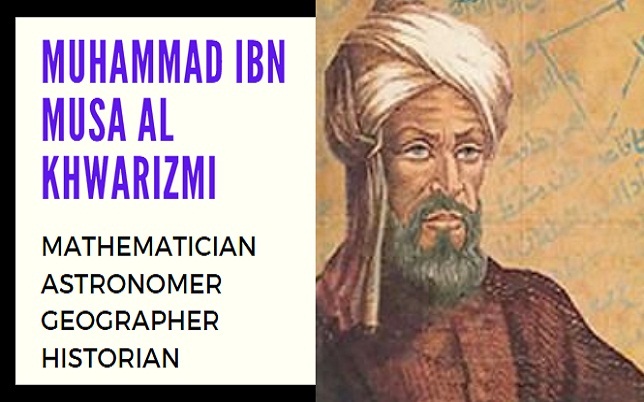Of all the great thinkers who have enriched the diverse branches of knowledge during the era of early Islam, Muhammad bin Musa Khwarizmi occupies an outstanding place. Being one of the greatest scientists of all times and the greatest of his age, Khwarizmi was a versatile genius who made lasting contributions to the field of Mathematics, Astronomy, Music, Geography and History.
Phillip K. Hitti writes in his well-known work, The History of the Arabs.
“Khwarizmi was the principal figure in the early history of Arabic Mathematics. One of the greatest minds of Islam, he influenced mathematical thought to a greater extent than any other medieval writer.”
Contents
When Muhammad Ibn Musa Al-Khwarizmi was born?
Muhammad bin Musa al-Khwarizmi (780-847 A.C.) was born in Khwarizm (Modern Khiva) situated on the lower course of Amu Darya. His forefathers had migrated from their native place and settled in Qutrubulli, a district West of Baghdad. Little is known about his early life.
According to H. Suter, he died between 835 to 844 A.D., while C. A. Nallino is more definite when he puts his death in 846-47 A.C.
Contributions of Al-Khwarizmi in Mathematics
Khwarizmi soon acquired a prominent place in the Darul Hukania founded by Mamoon, the celebrated Abbasid Caliph. He was entrusted with the astronomical researches conducted under the patronage of the talented Caliph.
As a mathematician, Khwarizmi has left ineffaceable marks on the pages of the mathematical history of the world. Undoubtedly he was one of the greatest and most original mathematicians that the world has produced.
Apart from compiling the oldest astronomical tables, he had the rare distinction of composing the oldest works on arithmetic as well as on algebra.
Writing about his celebrated work on algebra entitled ‘Hisab al Jabr wal Muqabala’, the author of the History of Arabs says:
“Translated in the 12th century in Latin by Gerard of Cremona, the work of Al-Khwarizmi was used until the 16th century as the principal mathematical text-book in European Universities and served to introduce into Europe the science of algebra, and with it the name of Al-Khwarizmi’s works were also responsible for the introduction into the West of the Arabic numerals called ‘Algorism’ after him.”
The mathematical works of Khwarizmi influenced such well-known mathematicians as Umar Khayyam, Leonardo Fibonacci of Pisa and Master Jacob of Florence.
His mathematical works were the principal source of knowledge on the subject to the world for a pretty long time.
George Sarton pays him glowing tributes when he considers him, as “one of the greatest scientists of his race and the greatest of his time“.
He systematized the Greek and Hindu mathematical knowledge. The oldest arithmetic composed by him was known as Kitab ul Jama-wat-Tafriq, which has disappeared in Arabic, but its Latin translation, ‘Frattati d’ Arithmetica’ edited by Bon Compagni in 1157 A.C. at Rome is extant.
Al-Khwarizmi was the first exponent of the use of numerals including Zero, in preference to letters. It was through him that Europe learnt the use of zero or cipher, whose employment facilitated the application of arithmetic in everyday life.
His work on the Indian method of calculations was translated into Latin by Adelard of Bath in the 12th century and was named as De Numero jndico which has survived, though the Arabic original was lost. According to J. Ruska, this Latin translation corresponds to his work on Hindi numeral, Kitab ul-Jama-wat Tafriq hi Hisab al Hind.
The Fihrist of Al Nadim, perhaps due to the mistake of the copyist has attributed to Sarad bin Ali, the three well known mathematical works of Khwarizmi, namely;
- Hisab al Hindi
- Al Jama-wat Tafriq
- Al Jabr wal Muqabla
AI Khwarizmi is the author of Hisab al Jabr wal Muqabla, an outstanding work on the subject which contains analytical solutions of linear and Quadratic equations.
He has the distinction of being one of the founders of algebra, who developed this branch of science to an exceptionally high degree. His great book contains calculations of integration and equations presented through over 800 examples.
He also introduced negative signs which were unknown to the Arabs and illustrated his point with six different examples. He also gives geometric solutions with figures of Quadratic equations.
Robert Chester was first to translate his book in Latin in 1145 A.C. which introduced algebra to Europe. Later on, this book was translated by Gerard of Cremona too. This Algebra written by Al Khwarizmi is lucid and well arranged. After dealing with equations of the second degree, he has dealt with algebraic, multiplications and divisions.
Writing in the Legacy of Islam, Carra De Vaux says:
“In 18th century Leonardo Fibonacci of Pisa, an algebraist of considerable importance says he owed a great deal to Arabs. He travelled in Egypt, Syria, Greece and Sicily and learned the Arabic method there, recognized it to be superior to the method of Pythagoras, and composed a Liber Abaci, in 15 Chapters, the rest of which deals with algebraic calculations. Leonardo enumerates the six cases of quadratic equations just as Al-Khwarizmi gives them.”
The translation of Khwarizmi’s algebra by Robert Chester marks an epoch for the introduction and advancement of this branch of science in Europe.
A modern orientalist says:
“The importance of Robert’s Latin translation of Khwarizmi’s algebra can hardly be exaggerated, because it marked the beginning of European algebra.”
Khwarizmi has made an invaluable contribution to trigonometry also. His trigonometric tables which deal with functions of sine and tangent were translated into Latin in 1126 A.C. by Adelard of Bath.
Contributions of Al-Khwarizmi in Astronomy
Khwarizmi was an astronomer of outstanding ability. Mamoon got a degree of meridian measured by him in the plain of Sanjar, North of the Euphrates, his astronomers employing a method superior to that of the Greeks. This was one of the most delicate geodetic operations successfully undertaken by a number of astronomers headed by Musa al-Khwarizmi, The idea behind these astronomical operations was the determination of the size and sphericity of earth.
The measurement was carried out at Sanjar as well as at Palmyra, which “yielded 56 3/4 Arabic miles as the length of a degree of meridian-a remarkably accurate result exceeding the real length of the degree at the place by about 2,877 ft.”, says C. A. Nallino.”This would make the diameter of earth 6,500 miles and its circumference 20,400 miles.”
He had written a valuable treatise on astronomy and had compiled his own tables (Zij) which was after two centuries revised by the Spanish astronomer Majriti and was translated into Latin by Adelard of Bath in 1126 A.C. This formed the basis of later astronomical pursuits in the East and the West, which replaced all earlier tables of Greek and Indian astronomers. This table was also adopted in China. It included values of trigonometric sine and tangent functions, which was in conformity with the tendency of the earlier writers when trigonometry was not considered a separate subject.
He wrote two books on astrolabe namely ‘Kitab al Amal bil Asturlab’, and ‘Kitab Amal al Asturlab’. The former dealt with the manner of using the astrolabe and the latter dealt with the art of making astrolabe. Kifti has mentioned the first book. He also wrote ‘AI Rukhama’, a book on Sundials which is non-extant.
Khwarizmi also dealt with the practical side of astrology. According to the celebrated astrologer Abu Mashar, he “investigated how far the conjunction at the time of Hazrat Muhammad’s (PBUH) birth indicated his future as a Prophet.”
Contributions of Al-Khwarizmi in Music
His mathematical treatise in which he has discussed his theory of music was translated by Adelard of Bath in the 12th Century and named as Liber Ysagogarum Alchorism. This contains a section on music. His views on music were conveyed to Europe through this Latin translation which according to Phillip K. Hitti, was one of the first to introduce Arab music to the Latin world.
Contributions of Al-Khwarizmi in Geography
Khwarizmi was also a Geographer of repute. His Kitab Surat al Ard (The work on the shape of the earth) laid the foundation of geographical science in Arabic. The manuscript of this book is preserved in Strassburg (Germany).
Abul Fida, the celebrated Geographer, calls it Kitab Rasm al Rub al Mamur. (The book of drawing of the inhabited parts of the globe). This book was illustrated with maps, whose Latin translation was edited by C. A. Nallino, who declared “that this is a work, like of which no European nation could have produced at the dawn of its scientific activity.”
Later on H. Von Mazik translated and edited this book as well as annotated the part dealing with Africa. This book corrected and completed earlier geographical facts and notions stated by Ptolemy.
Contributions of Al-Khwarizmi in History
Muhammad bin Musa AI Khwarizmi, a versatile genius of the Islamic history, had translated Sidhanta, or Indian Tables and had written commentary on it.
Khwarizmi wrote a book on history known as Kitab al-Tarikh, which served as a source for Masudi and Tabari. The history written by Tabari contains a passage about the return of Caliph Mamoon to Baghdad which was probably taken from this book.

